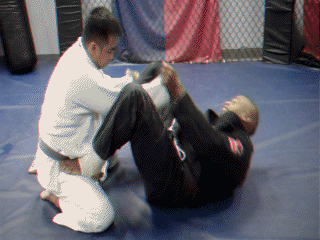Shrimping is one of the first movements you learn in Jiu-jitsu. It’s also often included in warmups in gyms all across the world. You’re told how important it is but it is often hard to see the relevance in the beginning.
The movement also doesn’t come naturally to everyone. In fact, I remember struggling with it during my first class, but now I have a stronger concept of how it applies to directly to the art.
That is what this post is about. We will explore what the shrimp is and focus on its applications.
It will be split into the following sections:
|
|
|
|
Just as a forewarning, there will be a lot of videos. I spent a few hours diving deep into Youtube, and I picked out some of the best videos on shrimping.
Shrimping Variations
There are primarily three types of shrimps:
- The backwards shrimp where you move your hips away.
- The forward shrimp where you move your hips in.
- The lateral shrimp where you move your hips to a side.
Both of them have many applications, but we tend to focus far more attention on the backwards motion. For example, out of all the videos I watched on shrimping, only two focused on the forward shrimp (or reverse shrimp as it’s also called) and one on the sideways shrimp. I bring that only to make it clear that you would benefit from not neglecting the other sides of the equation.
Shrimping is about more than just escaping from bad situations. It is a method of increasing your mobility on the ground, and if you’re mobile, the possibilities of what you can do increase exponentially.
Examples:
|
|
|
This last video gives you an overview of many hip movements. It includes:
- Regular hip escape
- Double hip escape.
- Sitting hip escape (butt scoot)
- Forward sitting up hip escape.
- Forward hip escape
- Turning on your knees (shrimp out).
Did you notice how Rafael’s shrimp differs from Henry’s? In the last video, Rafael was able to flex his knee completely. That allows him to cover a lot of distance on his shrimp, even despite the fact that he didn’t elevate his hips much. In the other example though, Henry couldn’t bring his heel all the way to his butt, so he had to elevate to cover the necessary distance.
This is a difference between physical attributes.
In my own case, I don’t have the flexibility to flex my knee completely, so elevation for me is really important. How you use the shrimp may be different, but find a way to make the movement work for you.
Defensive Applications
The two most common defensive applications of the shrimp are seen in side control and mount escapes. They are the first two that come to mind when you think about the shrimp. So these first two videos review the concepts that go into those escapes.
Examples:
Now let’s go into more uncommon territory.
Shrimp movements, both forward and backward, are very common in a lot of techniques. In fact, I’ve only started to realize how often I use the movement. My goal here is to help you realize the same thing, if you haven’t already, by giving you examples.
The first is a knee on belly escape that uses the forward movement to establish a position of leverage, and the second uses the same movement to escape from S mount.
When it comes to escaping bad situations, movement is only one component of success. There is also an element of timing. For that reason, the next examples I found for you focus on when to shrimp for the maximum effect.
Examples:
There are many more examples of the shrimp in action when it comes to defense, but shrimping is not only a defensive movement.
Offensive Applications
When it comes to offense though, there is an issue. We take offensive hip movement for granted, and it is uncommon for it to be emphasized in instruction. That made it more difficult to find examples. So I will come back to this topic at a later date, with more information.
For now though, here are three examples:
- Spider guard triangle: The shrimp is used to create space for offense. That’s a very common use, and in this case, it’s initiated from foot on hips.
- Closed guard triangle: This is the lateral shrimp in action. A scissor motion on the body is used to escape the hips to the side, which gives you the angle to proceed with the attack. I use that movement in some of my armbar and scissor sweep variations from guard. It removes the need to place a foot on the hips or on the ground.
- Half guard shovel sweep: Did you notice how he shoots his hips under to gain leverage for the sweep? That is a reverse shrimp movement, and you also saw the same thing earlier in that knee on belly escape technique. All these movements have many applications.
Consider this just the tip of the iceberg. Common movements can be identified in a wide array of techniques and finding them all will be a long term project.
Partner Drills
As a bonus, these are a series of drills that you can use to make practicing shrimping a little more interesting.

Drills:
|
|
|
If you’ve gained some knowledge from any of the videos shown here, go to Youtube and subscribe to channels, comment on videos and share content. It will encourage them to produce more, and we all benefit from that.
Jiu-jitsu still has far more room to grow.


